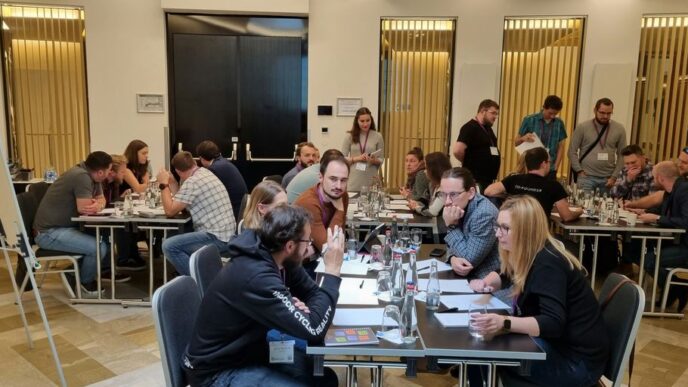Thinking about funding your next big idea? Crowdfunding has become a super popular way to get projects off the ground, but it’s not a magic bullet. Like anything, there are good parts and not-so-good parts. If you’re weighing your options, understanding the crowdfunding advantages and disadvantages is a must before you jump in.
Key Takeaways
- Crowdfunding can get you money from lots of different people and help prove your idea is good.
- You can pick from various funding types, like equity or rewards, to fit what your project needs.
- Running a crowdfunding campaign can get your brand noticed and even act as a marketing tool.
- Be ready for public scrutiny and make sure you follow all the rules, as there are risks involved.
- It’s smart to have a clear plan, build a community, and be honest with your backers to make your campaign a success.
Advantages of Crowdfunding
Crowdfunding has become a really popular way to get projects off the ground, and for good reason. It’s not just about the money; it’s about a whole bunch of other cool stuff too. Let’s break down some of the biggest perks.
Access to Capital and Diverse Investor Base
One of the most obvious advantages is, well, the money! Crowdfunding opens doors to a huge pool of potential investors that you might not otherwise reach. Instead of relying on a few big investors, you can tap into a crowd of people who are excited about your idea. This is especially helpful if traditional funding sources are a no-go. You can find crowdfunding websites to help you get started.
Market Validation and Customer Engagement
Crowdfunding isn’t just about raising cash; it’s also a fantastic way to see if your idea actually resonates with people. If people are willing to put their money behind your project before it even launches, that’s a pretty good sign that you’re onto something. Plus, it gives you a chance to connect with your early adopters, get their feedback, and build a community around your product or service. This early engagement can be super valuable in shaping your offering and making sure it’s something people really want.
Flexible Financing Options
Unlike traditional loans or venture capital, crowdfunding offers a lot of flexibility in how you structure your funding. You can choose from different models, like:
- Rewards-based crowdfunding: People donate in exchange for perks or early access to your product.
- Equity crowdfunding: Investors get a piece of your company in exchange for their investment.
- Debt crowdfunding: You borrow money that you pay back with interest.
This flexibility lets you tailor your approach to fit your specific needs and the level of investor involvement you’re comfortable with. It’s not a one-size-fits-all situation, which is a huge plus.
Brand Exposure and Marketing Benefits
A well-run crowdfunding campaign can generate a ton of buzz and get your brand in front of a lot of new people. Media outlets, industry experts, and potential customers might all take notice, giving you a major boost in visibility. Think of it as a marketing campaign that also happens to raise money. It’s a great way to create excitement and attract attention even before your product is ready. This can really help with brand exposure and getting your name out there.
Disadvantages of Crowdfunding
Crowdfunding isn’t all sunshine and rainbows. There are definitely some downsides you need to think about before jumping in. It’s not just free money; it comes with its own set of challenges.
Reputational Risks
Crowdfunding campaigns play out in public. This means any missteps or failures are visible to everyone. If you don’t deliver on your promises, or if your product is a dud, it can seriously damage your reputation. People are quick to share negative experiences online, and that can have lasting consequences for your brand. It’s a high-stakes game.
Regulatory Challenges and Compliance
Depending on the type of crowdfunding you choose (equity, debt, rewards), you might face a bunch of regulatory hurdles. There are rules about what you can say in your campaign, how you handle investor money, and what kind of reporting you need to do. Messing up these regulations can lead to fines or even legal trouble. It’s important to do your homework and maybe even talk to a lawyer before you start.
Limited Due Diligence and Information Asymmetry
Unlike traditional investors, crowdfunding backers often have limited information about your business. They’re relying on what you present in your campaign, which can create an information gap. This lack of due diligence can lead to unrealistic expectations and potential conflicts down the road. It’s your job to be as transparent as possible, but even then, there’s a risk that backers won’t fully understand the risks involved. This is why it’s important to have a solid marketing strategy in place.
Navigating the Crowdfunding Landscape
So, you’re thinking about crowdfunding? It’s not as simple as throwing up a page and watching the money roll in. There’s a lot to consider. Let’s break down some key things you need to know to actually make it work.
Understanding Platform Specifics
Each crowdfunding platform is different. Kickstarter isn’t Indiegogo, and neither is GoFundMe. They all have different audiences, fee structures, and rules. You need to do your homework and pick the platform that best fits your project and target audience. For example, if you’re working on a tech gadget, a platform known for innovation might be a better bet. If it’s a charitable cause, another platform might be more appropriate. Don’t just pick the first one you see. Take the time to compare and contrast. Look into the different fintech startups and their offerings.
Crafting a Compelling Campaign
Your campaign page is your sales pitch. It needs to grab people’s attention and convince them to open their wallets. Here’s what you need:
- A clear and concise description of your project.
- High-quality images and videos.
- A breakdown of how the funds will be used.
- Attractive rewards for backers.
Don’t skimp on the visuals. People are more likely to back a project if they can see what they’re getting. And make sure your rewards are actually appealing. A signed photo might not cut it. Think about offering exclusive access, early bird discounts, or personalized experiences. Make sure you have a good understanding of equity crowdfunding.
Post-Campaign Investor Relations
The campaign is over, but your job isn’t. You need to keep your backers in the loop. Provide regular updates on your progress, even if there are delays. Be transparent about any challenges you face. And most importantly, deliver on your promises. If you said you’d ship a product by a certain date, do everything you can to make that happen. Backers are more than just investors; they’re your early adopters and brand advocates. Treat them well, and they’ll support you in the long run. Good communication with backers is key.
Strategic Considerations for Crowdfunding Success
Crowdfunding isn’t just about throwing a page online and hoping for the best. It’s a strategic game, and if you want to win, you need a plan. It’s about more than just raising money; it’s about building a community and telling a story that people want to be a part of. Let’s break down some key things to think about.
Defining Clear Funding Goals
Before you even think about platforms or perks, you need to know exactly how much money you need and what you’re going to do with it. Vague goals lead to vague results. Don’t just say you need money for "development"; break it down. How much for materials? How much for labor? How much for marketing? The more specific you are, the more credible you’ll appear to potential backers. Think about it like this:
- Phase 1: Prototype Development: $5,000 (Materials: $2,000, Labor: $3,000)
- Phase 2: Manufacturing: $15,000 (Equipment: $8,000, Initial Production Run: $7,000)
- Phase 3: Marketing & Distribution: $5,000 (Advertising: $2,000, Shipping: $3,000)
Having a clear breakdown not only helps you stay on track but also shows backers you’ve thought things through. This is where you can conduct in-depth due diligence to ensure your project is viable.
Building a Strong Community
Crowdfunding is as much about community as it is about capital. You’re not just asking for money; you’re inviting people to join your journey. That means engaging with potential backers before you launch your campaign. Start building an email list, get active on social media, and talk to people about your project. Show them you’re passionate and that you value their input. Think of your early backers as your core team. They’re the ones who will spread the word and help you reach a wider audience. Here’s how to start:
- Identify your target audience: Who are the people most likely to be interested in your project?
- Engage on social media: Share updates, ask for feedback, and respond to comments.
- Build an email list: Offer exclusive content or early access to your campaign.
Leveraging Storytelling for Engagement
People don’t just back projects; they back stories. Your crowdfunding page isn’t just a sales pitch; it’s an opportunity to connect with people on an emotional level. Tell them why you’re passionate about your project, what problem it solves, and how it will make a difference. Use compelling visuals, like videos and images, to bring your story to life. Don’t be afraid to be vulnerable and share your challenges. Authenticity goes a long way. Remember to highlight the excellent customer service you plan to provide post-campaign. Here are some storytelling tips:
- Focus on the problem: What issue are you trying to solve?
- Highlight the solution: How does your project address the problem?
- Show the impact: How will your project make a difference in people’s lives?
Mitigating Crowdfunding Risks

Crowdfunding, while exciting, isn’t without its potential pitfalls. It’s super important to plan ahead and think about how to handle things if they don’t go exactly as planned. Let’s look at some ways to reduce those risks.
Thorough Legal and Financial Preparation
Before you even think about launching a campaign, get your legal and financial ducks in a row. This means talking to a lawyer who knows crowdfunding regulations and an accountant who can help you project costs and revenue. Having these experts on your side can save you a ton of headaches later on. Make sure you understand all the compliance requirements, because failing to comply can lead to penalties or even the suspension of your campaign. It’s also a good idea to do your homework on due diligence to avoid uncertainty.
Transparent Communication with Backers
Communication is key! Keep your backers in the loop, even when things get tough. Provide regular updates on your progress, and be honest about any challenges you’re facing. If there are delays, explain why and what you’re doing to fix them. Backers appreciate transparency, and it builds trust. Remember to provide estimated delivery dates and potential risks for rewards. This helps manage expectations and shows you’re thinking ahead. A good rule of thumb is to over-communicate rather than under-communicate. This helps maintain brand integrity.
Contingency Planning for Underfunding
What happens if you don’t reach your funding goal? It’s a question every campaign creator needs to ask. Have a backup plan in place. This could involve:
- Scaling down your project to match the funds you did raise.
- Seeking alternative funding sources, like loans or angel investors.
- Returning the money to backers (if that’s part of your platform’s policy).
It’s better to have a plan and not need it than to be caught off guard. Think about what you’ll do if you only get 50% of your goal, or 75%. Having these scenarios mapped out will help you make quick, informed decisions if things don’t go as planned. Also, be aware of potential reputational risks if the campaign is unsuccessful.
The Role of Crowdfunding in Business Growth

Accelerating Product Development
Crowdfunding can really speed up how quickly you can get a product from the idea stage to actually being on the market. The cash you raise can go directly into research, prototyping, and initial production runs. It’s not just about the money, though. The feedback you get during the campaign can help you refine your product based on what potential customers actually want. Think of it as real-time market research that also funds your project. Plus, a successful campaign can create a buzz around your product, making the launch even bigger.
Expanding Market Reach
One of the coolest things about crowdfunding is that it can help you reach people you never would have otherwise. It’s not just about getting money from your immediate network. A well-run campaign can get attention from people all over the world. This is especially true if you’re using a platform with a big reach. You can use crowdfunding websites to get your product in front of a global audience, test new markets, and build a customer base before you even officially launch. It’s like having a built-in marketing team that’s also investing in your success.
Fostering Innovation and Creativity
Crowdfunding can be a great way to encourage new ideas and creative projects. It allows you to bypass traditional gatekeepers like banks or venture capitalists, who might be hesitant to fund something that’s a little out there. With crowdfunding, you can pitch your idea directly to the people who are most likely to be excited about it. This can lead to more diverse and innovative products and services. Plus, the community aspect of crowdfunding can provide valuable support and encouragement, helping you validate the market and push your creative boundaries. It’s a win-win for both creators and consumers.
Long-Term Implications of Crowdfunding
Crowdfunding isn’t just about getting that initial cash injection; it’s about what happens after the campaign ends. It’s easy to get caught up in the excitement of hitting your goal, but the real work begins once the funds are secured. You’ve got promises to keep, a community to nurture, and a business to build. Let’s look at some of the long-term implications.
Managing Investor Expectations
One of the biggest challenges is managing the expectations of your backers. They’re not just customers; they’re investors, even if they only pledged a small amount. They’re going to want updates, and they’re going to want to see progress. If you promised a product by a certain date, you better deliver, or at least communicate honestly about any delays. Think of them as a group of fintech investors who are really interested in your success. Here’s a few things to keep in mind:
- Regular Updates: Keep your backers in the loop with frequent updates, even if there’s not much to report. Transparency is key.
- Honest Communication: If things go wrong (and they often do), be honest about it. Don’t try to sugarcoat the situation.
- Realistic Timelines: Don’t overpromise. Set realistic timelines for product development and delivery.
Maintaining Brand Integrity
Your crowdfunding campaign has likely created a certain image for your brand. You need to make sure that your actions after the campaign align with that image. If you presented yourself as an eco-friendly company, you can’t suddenly start using unsustainable practices. Maintaining brand integrity is about consistency and authenticity. Here’s how to do it:
- Stay True to Your Values: Don’t compromise your core values for short-term gains.
- Deliver on Your Promises: If you promised a certain level of quality, make sure you deliver it.
- Be Responsive to Feedback: Pay attention to what your backers and customers are saying, and respond to their concerns.
Scaling Operations Post-Campaign
So, you got the money. Now what? Can your business handle the increased demand? Do you have the infrastructure in place to scale your operations? Scaling too quickly can be just as dangerous as not scaling at all. You need to have a plan in place for how you’re going to grow your business. This might involve:
- Hiring New Staff: Do you need to hire more people to handle the increased workload?
- Investing in Infrastructure: Do you need to invest in new equipment or technology?
- Streamlining Processes: Can you streamline your processes to improve efficiency?
Crowdfunding can be a great way to get your business off the ground, but it’s important to remember that it’s just the beginning. The real challenge is building a sustainable business that can thrive in the long term. Think about how you can use equity crowdfunding to further expand your business after the initial campaign.
Conclusion
So, what’s the big takeaway here? Crowdfunding can be a pretty cool way to get your project off the ground, but it’s not some magic bullet. You get to tap into a bunch of different people for money, which is awesome, and it can even help you figure out if folks actually want what you’re selling. Plus, you’ve got some wiggle room with how you get that money. But, and this is a big "but," there are definitely some tricky parts. You’ve got to deal with all the rules, there’s always a chance things won’t go as planned with investors, and sometimes you don’t get to dig deep enough into the details of what you’re buying. And yeah, your reputation is on the line. Before you jump into a crowdfunding campaign, really do your homework. Talk to people who know their stuff, and weigh the good against the bad. Knowing all this helps you make smart choices and move through the crowdfunding world without too many bumps.
Frequently Asked Questions
Why do so many small businesses start with crowdfunding?
Crowdfunding lets you get money from lots of people, not just big banks. It also helps you see if people even want what you’re selling before you fully make it. Plus, you can often choose how you get the money, like giving away a piece of your company or just getting pledges for a product.
What are the main downsides of crowdfunding?
It can be tricky because everyone sees your campaign, so if things go wrong, it’s public. There are also lots of rules you have to follow, and it can be hard to check out every investor or give them all the info they need quickly.
How can I make my crowdfunding campaign successful?
You need to pick the right platform for your idea, make your project sound really exciting, and then keep talking to the people who gave you money even after the campaign is over.
What are some smart things to think about for crowdfunding?
Before you start, know exactly how much money you need and what it’s for. Build a group of people who love your idea, and tell your story in a way that makes people want to help.
How can I avoid problems when crowdfunding?
Make sure you’ve done all your legal and money homework. Be super honest with people who back your project. And have a backup plan in case you don’t raise all the money you hoped for.
How does crowdfunding help a business grow?
Crowdfunding can help you make new products faster, reach more customers, and come up with fresh ideas because you’re getting feedback and support from a wide audience.














